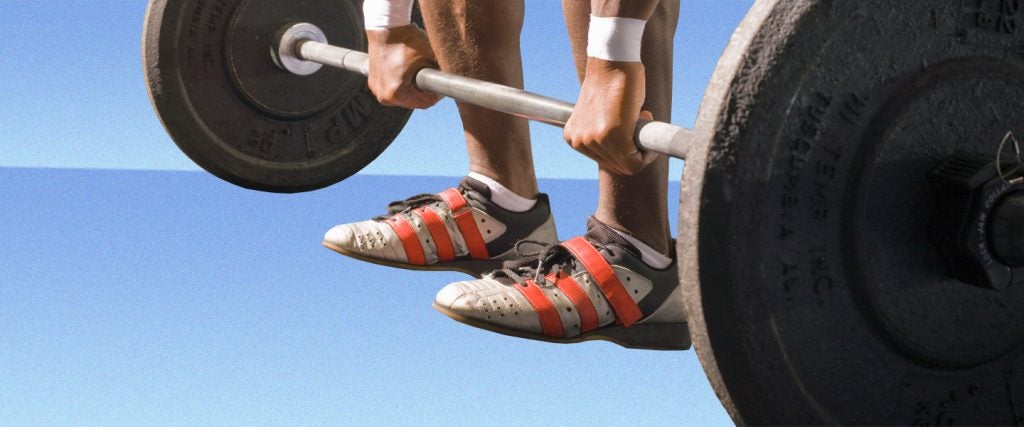The specialization of workout gear is now such that there’s footwear for practically every physical activity — from treadmill and stepmill shoes, to rucking and elliptical shoes, to most nonsensically of all, swimming shoes.
And yet, despite the incessant push for new shoe after new shoe, specialized weightlifting footwear has actually been around since at least the 1960s. So what’s its deal? Are these curiously shaped, low-top shoes with laces and straps merely an early grift, or do they legitimately better serve your weightlifting gains? After all, outside of leg day (which is often best conducted barefoot), it’s not as though your feet are getting much of a workout when you’re benching or doing bicep curls.
Yeah, what is the point of weightlifting shoes?
Well, for starters, they’re not really for the casual weightlifter. Quite the contrary: They’re designed with the needs of the hardest of the hardcore weightlifters and powerlifters in mind — the people who are pouring every iota of strength into maximizing the Herculean force they invest into each lift.
Along those lines, while there may be a 10-rep warmup set or two thrown somewhere into the mix, the majority of powerlifting sets are performed in low numbers with extremely heavy weights. We’re also talking about a lot of compound lifts here — e.g., squats, deadlifts, snatches and all varieties of cleans — which provide the foundation for certified competitions.
Again, weightlifting shoes are specifically constructed to meet such training regimens.
So should I wear them or not?
It really depends on how serious of a weightlifter you are. As I just mentioned, weightlifting shoes have been built with the utmost stability in mind for the execution of highly technical strength lifts, and nothing else. In particular, their heels have been elevated to increase ankle flexibility, and to help the body maintain an upright, balanced posture.
Another reason the heels likely have been reinforced is because the proper execution of the snatch and clean-and-jerk lifts requires your feet to leave the floor as they accelerate through the pull and try to generate as much upward momentum with the weight as possible. Given that you’re jumping and landing with hundreds of pounds bearing down on your joints, a reinforced heel definitely helps.
The outsole, however, remains stiff and flat, and doesn’t compress at all. For good reason, too: When you’re trying to maintain control over quantities of weight that can cause near decapitation if mismanaged, one of the last things you want is for your foot to go sliding around inside of your shoe.
But don’t I need these for shoes for CrossFit, too?
I knew this question was coming, primarily due to the fact that several stores catering to CrossFit go out of their way to market weightlifting shoes to CrossFitters.
But CrossFit is intended to involve constant variations, functional movements and high intensity. Traditional weightlifting movements are certainly very functional, and are inarguably high intensity, but there’s no variation to them, and weightlifting shoes are developed with this lack of variance in mind.
For instance, look at this workout pulled directly from the CrossFit website:
- 24 double-unders
- 19 toes-to-bars
- 2 clean and jerks
- 400-meter run
Since double-unders are performed with a jump rope, you’ll want a shoe that’s lightweight with outsoles that compress to effectuate a comfortable spring from the balls of your feet while reliably gripping the floor on impact. The toes-to-bars movement is a rapid-fire version of a hanging leg raise, and the shoes you wear for it won’t matter unless they’re incredibly heavy. The clean-and-jerks will certainly be aided by weightlifting shoes, but the 400-meter run is obviously best performed in a running shoe that has an outsole that’s very responsive to ground contact, with excellent traction.
Essentially, weightlifting shoes — with their vastly exaggerated heel height — are going to be a hindrance in half of the exercises included in this workout. Plus, it’s debatable whether an average CrossFitter will be adequately trained enough in a highly technical Olympic lift like the clean-and-jerk for weightlifting shoes to make much of a difference.
Should I just stick to cross-trainers then?
That would be my recommendation. They’ll serviceably facilitate everything from lifting weights, to running on a track, to sneaking off to the stepmill, to competing in an impromptu game of tennis. Now, if you’re going to lift like a competitive weightlifter, by all means buy weightlifting shoes. Otherwise, I’d turn and walk right away from them in whatever shoes you currently have on your feet.

